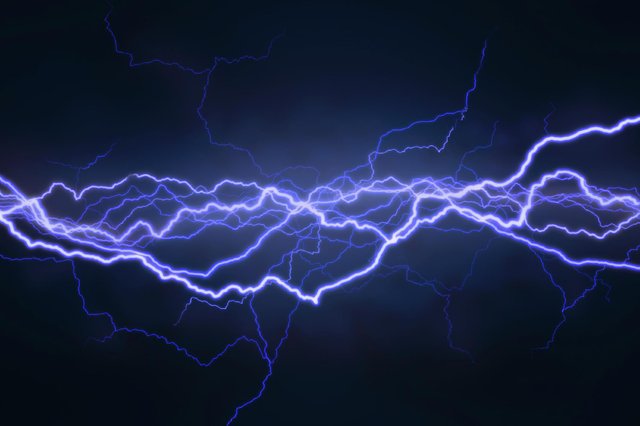System upgrade - The world of tomorrow [Energy usage]
Because of the popularity of electrical devices and sources and the global electrical grid network, this article is about the electrical energy usage.
Electrical energy is energy that is stored in charged particles within an electric field. Electric fields are simply areas surrounding a charged particle. In other words, charged particles create electric fields that exert force on other charged particles within the field.
Electrical energy can be used to move charged particles through a wire from a power plant to our homes and businesses. The movement of a charged particle through a wire is called current, or more commonly, electricity.
The word "usage" means transition or transformation, the conversion of an electrical current into an other form of energy.
Kinetic (mechanical)
Electric motor
An electric motor is an electrical machine that converts electrical energy into mechanical energy. The reverse of this is the conversion of mechanical energy into electrical energy and is done by an electric generator.
In normal motoring mode, most electric motors operate through the interaction between an electric motor's magnetic field and winding currents to generate force within the motor. In certain applications, such as in the transportation industry with traction motors, electric motors can operate in both motoring and generating or braking modes to also produce electrical energy from mechanical energy.
Maximum efficiency is usually near 75%. Effciency is often lower due to a too light load, when the load is at it's peak of suitability, the efficiency is about 90% and can practically go up to 95%.
Considering the fact that most combustion engines efficiency is around 20%, electric motor are around 4 times more efficient.
Thermal
Electric heater
Electric heating is a process in which electrical energy is converted to heat. Common applications include space heating, cooking, water heating and industrial processes. An electric heater is an electrical device that converts electric current to heat.
The heating element inside every electric heater is an electrical resistor, and works on the principle of Joule heating: an electric current passing through a resistor will convert that electrical energy into heat energy.
Efficiency is about 100%.
Chemical
Electrolysis
Electrolysis of water is the decomposition of water (H2O) into oxygen (O2) and hydrogen gas (H2) due to an electric current being passed through the water. The process convert an electrical energy into a chemical energy.
In order to process electrolysis of water, their is a need of:
- Direct Current
- Water
- Electrocatalyst that can be made in (from low effiency to high effiency / low cost to high cost):
- Stainless steel
- Carbon(graphite)
- Carbon(graphite) + platinum
- C3N4@NG
The reaction of theses 3 components in some conditions produce hydrogen and oxygen at a ratio of 2:1.
Note: All components are buyable and relatively cheap except C3N4@NG that is impossible to buy but posses the highest effiency. C3N4@NG can only be made with a particle accelerator that can only be legally homemade built.
Electrolysis efficency can go up to 96% and is about 73% in average for commercial electrolysis products.
source 1, source 2, source 3, source 4, source 5
Radiant (Electromagnetic radiation, including light)
Light-emitting diode (LED)
A light-emitting diode is a semiconductor diode which glows when a voltage is applied. The process convert electrical energy into visible electromagnetic radiation (light).
LED lamps have a lifespan and electrical efficiency which are several times greater than incandescent lamps, and are significantly more efficient than most fluorescent lamps. Thus maid the LED lamp technology the most efficient for lighthing.
The average lifespan is about 15'000 hours and 50'000 switch cycles, the lifespan can go up to 25'000 hours for the best manufacturers and the technological limitation is about 50'000 hours.
LED often contains heavy metals that can pose, in specific conditions, health, humanitarian and ecological problems but the main problem with LEDs is the fact that they emit primarily blue wavelengths and lack the counterbalancing healing and regenerative near-infrared frequencies. Theses issues can be technologicaly solved in the time to come.
In despit of their issues, LED lamps stays the best lighting technology, considering that major issues could/are already be solved depending the manufacturer.
LED efficiency is between 10% and 43.9% but closer than 10% in average.
source 1, source 2, source 3, source 4
Magnetic
An electromagnet is a type of magnet in which the magnetic field is produced by an electric current. The magnetic field disappears when the current is turned off. Electromagnets usually consist of insulated wire wound into a coil. A current through the wire creates a magnetic field which is concentrated in the hole in the center of the coil. The wire turns are often wound around a magnetic core made from a ferromagnetic or ferrimagnetic material such as iron; the magnetic core concentrates the magnetic flux and makes a more powerful magnet.
The main advantage of an electromagnet over a permanent magnet is that the magnetic field can be quickly changed by controlling the amount of electric current in the winding. However, unlike a permanent magnet that needs no power, an electromagnet requires a continuous supply of current to maintain the magnetic field.
Electromagnets are widely used as components of other electrical devices, such as motors, generators, relays, loudspeakers, hard disks, MRI machines, scientific instruments, magnetic levitation train, and magnetic separation equipment. Electromagnets are also employed in industry for picking up and moving heavy iron objects such as scrap iron and steel.
The efficiency is between 20% and 95% as the main problem come from the thrust that is often not suited with the power input.
Part of: System upgrade - The world of tomorrow
